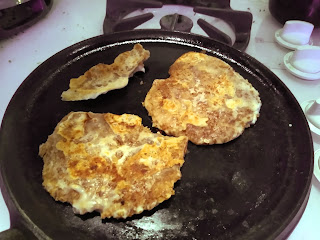It was the perfect confluence of desires. One person wanted delicious chocolate things, and I wanted to get out a new recipe from an old book.
One person in the house likes exploring cookie recipes as much as I love making different kinds of brownies. My biggest problem with cookie recipes is that unless you have a double
oven, you will have to spend a long time baking batches one at a time. But, these are drop cookies. Meaning, you don't have to spend all that time hand-shaping several pans' worth of dough pats into crescents or suchlike. So is a minor inconvenience, and it's actually not bad at all when you have company in the kitchen.
|
Chocolate Chip Drop Cookies ½ c butter or other shortening (margarine, vegetable shortening, etc) ⅔ c brown sugar ½ tsp soda Dash of salt 1 egg 1 tsp vanilla ½ c milk 3 oz unsweetened chocolate, melted* ½ c walnuts, chopped 1 (12-oz) package chocolate chips Heat oven to 350°. Grease a baking sheet. Cream butter, soda, salt, and sugar. Add egg and vanilla, beat well. Add the flour alternately with the milk. Fold in the chocolate chips and the nuts. Drop from a spoon and bake 10 minutes. They don't really spread or change shape much in the oven. So if you want them flatter or rounder, shape them before baking. Frost with chocolate buttercream. *If you do not have baking chocolate, increase butter by 3 tablespoons. Add 9 tablespoons (that's ½ cup plus 1 tbsp) of cocoa powder to the butter and sugar when creaming them together.
Elizabeth Dedinsky (Whiting, Indiana), Anniversary Slovak-American Cook Book, First Catholic Slovak Ladies' Union, 1952
|
And so, we launch today's recipe with a lot of butter! I was very interested in the choice of brown sugar instead of white. Would we be able to taste any difference after the chocolate and the chocolate chips?
Speaking of chocolate, this recipe uses a lot of it. We went from stirring butter and sugar to mixing an intoxicating tar.
The dough lightened in color a bit when we added the flour to it. We also realized that we had the makings of a lot of cookies on our hands. The spoon is totally immersed in future cookies.
The recipe tells us to use "one package chocolate chips." I know a lot of people will carefully make sure they're using the correct package size for the time period, but they have newspaper database subscriptions and therefore can flip through grocery store flyers from any year they like. We at A Book of Cookrye just hoped that they used the same 12-ounce bags in 1952 that you can get off the shelf today. You will notice that this is a lot of chocolate chips for this amount of dough. I'm not sure if we are baking cookies with chocolate chips in them, or if we are baking chocolate chips held together by cookie dough.
Having chosen this recipe for convenience, I dropped these things from a spoon as the recipe said to. The recipe doesn't say anything about flattening them, shaping them, or doing anything else to them. They don't exactly tantalize the eye, do they?
They came out of the oven looking as clump-shaped as before. With that in mind, I tried to flatten batch #2 a bit before getting them into the oven, but the dough was so sticky that I couldn't make it stay flat when I tried to get my fingers off of them.
However, we are directed to frost these, and who am I to argue with recipe writers? Drawing on previous experience, we decided to squirt the icing on rather than spread it. I was hoping for cute swirls that would make these look less like little rocks, but that didn't happen.
Perhaps it was for the aesthetic good that we ran out of icing before we ran out of cookies. (Also, this recipe makes a lot of cookies. Prepare to give up large tracts of counterspace while they cool off.) You can see where we ran out of icing and tried to hastily add extra sugar and chocolate powder to the tiny remaining bowl scrapings to make it cover the many, many cookies that remained.
This feels oddly like we've gotten the recipe from a formidable matriarch in a floral apron. Maybe it's because it makes so many cookies (they will conquer every flat surface in the kitchen before you can let the oven rest), they are so rich, and they seem like they're made to be given away to all the children, nieces, and nephews before taking a big box of extras to the church bake sale.
As a bonus serving suggestion, these go very well with ice cream.


































































